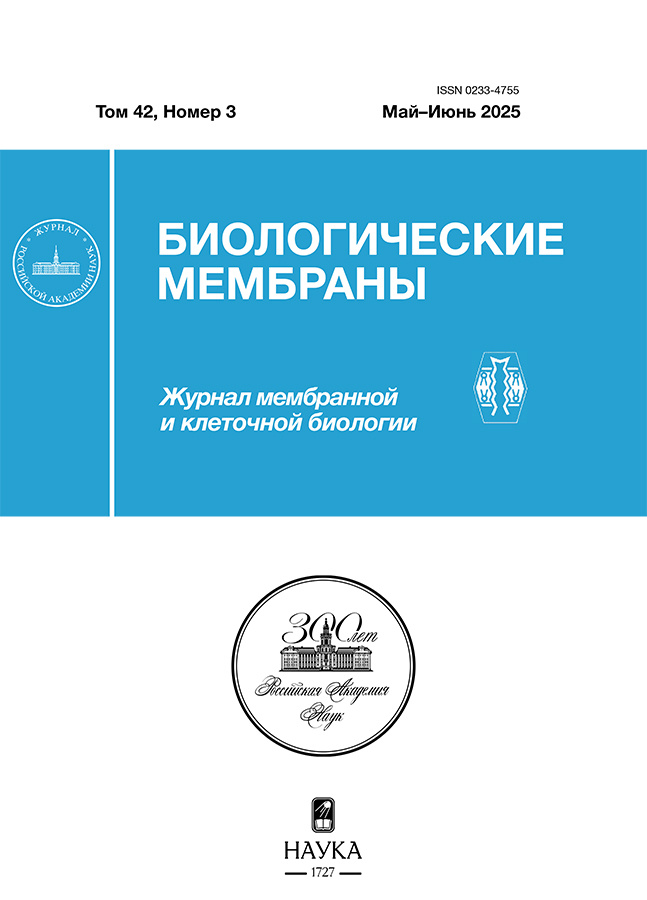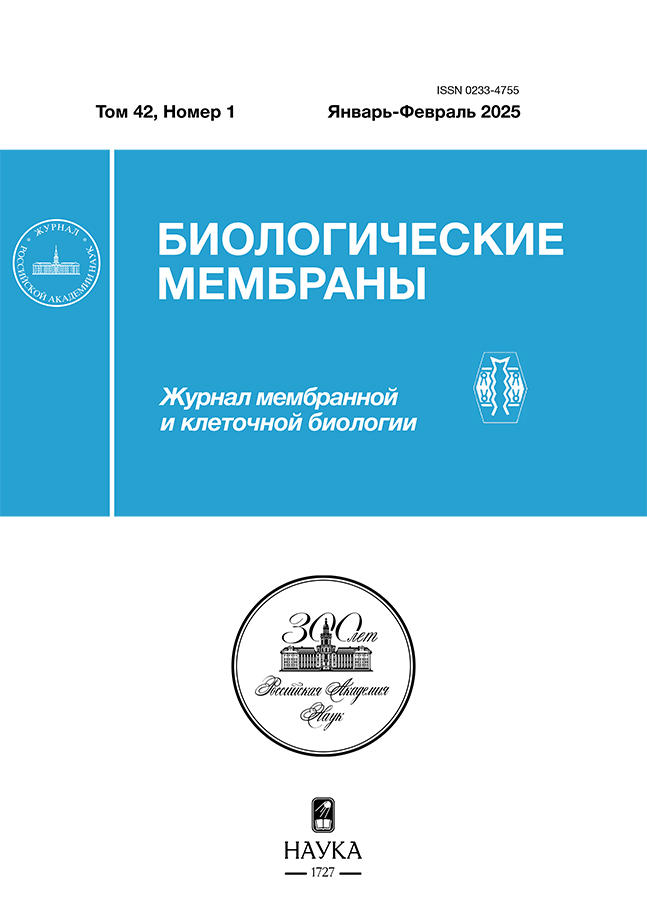Oxygenic photosynthesis: induction of chlorophyll a fluorescence and regulation of electron transport in thylakoid membranes in silico
- Authors: Vershubskii A.V.1, Priklonskii V.I.1, Tikhonov A.N.1
-
Affiliations:
- Moscow Lomonosov State University
- Issue: Vol 42, No 1 (2025)
- Pages: 3-19
- Section: Articles
- URL: https://clinpractice.ru/0233-4755/article/view/681132
- DOI: https://doi.org/10.31857/S0233475525010015
- EDN: https://elibrary.ru/uuknus
- ID: 681132
Cite item
Abstract
The paper describes an extended mathematical model for the regulation of the key stages of electron transfer in the photosynthetic chain of electron transport (CET) and the associated processes of trans-thylakoid proton transfer and ATP synthesis in chloroplasts. This model includes primary plastoquinone PQA, associated with photosystem 2 (PS2), and secondary plastoquinone PQB, exchanging with plastoquinone molecules that are part of the pool of electronic carriers between PS2 and photosystem 1 (PS1). The model adequately describes the multiphase non-monotonic curves of chlorophyll fluorescence induction and the kinetics of P700 redox transformations (photoreaction center PS1), plastoquinone, changes in ATP and pH concentrations in lumen (pHin) and stroma (pHout) depending on the illuminating conditions of chloroplasts (variation in intensity and spectral composition of light). The results of computer simulation are consistent with experimental data on the kinetics of photoinduced P700 transformations in the leaves of higher plants and the induction of chlorophyll a fluorescence. The obtained data are discussed in the context of "short-term" mechanisms of pH-dependent regulation of electron transport in intact chloroplasts (non-photochemical quenching of excitation in PS2 and activation of Calvin–Benson cycle reactions).
Full Text
About the authors
A. V. Vershubskii
Moscow Lomonosov State University
Email: an_tikhonov@mail.ru
Faculty of Physics
Russian Federation, Moscow, 119991V. I. Priklonskii
Moscow Lomonosov State University
Email: an_tikhonov@mail.ru
Faculty of Physics
Russian Federation, Moscow, 119991A. N. Tikhonov
Moscow Lomonosov State University
Author for correspondence.
Email: an_tikhonov@mail.ru
Russian Federation, Moscow, 119991
References
- Эдвардс Д., Уокер Д. 1986. Фотосинтез С3- и С4 растений: механизмы и регуляция. М.: Мир. 320 с.
- Blankenship R.E. 2002. Molecular mechanisms of photosynthesis. Malden, MA: Blackwell Science Inc.
- Buckanan B.B. 1980. Role of light in the regulation of chloroplast enzymes. Ann. Rev. Plant Physiol. 31, 341–374.
- Demmig-Adams B., Cohu C.M., Muller O., Adams W.W. 2012. Modulation of photosynthetic energy conversion efficiency in nature: From seconds to seasons. Photosynth. Res. 113(1–3), 75–88.
- Kono M., Terashima I. 2014. Long-term and short-term responses of the photosynthetic electron transport to fluctuating light. J. Photochem. Photobiol. B: Biology. 137, 89–99.
- Tikhonov A.N. 2015. Induction events and short-term regulation of electron transport in chloroplasts: An overview, Photosynth. Res. 125, 65–94.
- Matsubara S., Förster B., Waterman M., Robinson S.A., Pogson B.J., Gunning B., Osmond B. 2012. From ecophysiology to phenomics: Some implications of photoprotection and shade–sun acclimation in situ for dynamics of thylakoids in vitro. Philos. Trans. R. Soc. Lond. B: Biol. Sci. 367 (1608), 3503–3514.
- Li Z., Wakao S., Fischer B.B., Niyogi K.K. Sensing and responding to excess light. Ann. Rev. Plant Biol. 60 (1), 239–260.
- Kasahara M., Kagawa T., Oikawa K., Suetsugu N., Miyao M., Wada M. 2002. Chloroplast avoidance movement reduces photodamage in plants. Nature. 420 (6917), 829–832.
- Kaiser E., Morales A., Harbinson J., Kromdijk J., Heuvelink E., Marcelis L. F. M. 2015. Dynamic photosynthesis in different environmental conditions. J. Exper. Botany, 66 (9), 2415–2426.
- Puthiyaveetil S., Kirchhoff H., Huhner R. 2016. Structural and functional dynamics of the thylakoid membrane system. In Chloroplasts: Current research and future trends. Ed., H. Kirchhoff. Norfolk, UK: Caister Academic Press, p. 59–87.
- Tikhonov A.N. 2018. The cytochrome complex: Biophysical aspects of its functioning in chloroplasts. In Membrane protein complexes: Structure and function, subcellular biochemistry. Eds. Harris J.R., Boekema E.J. Singapore: Springer, Subcell. Biochem. 87, p. 287–328. doi: 10.1007/978-981-10-7757-9_10.
- Malone L.A., Proctor M.S., Hitchcock A., Hunter C.N., Johnson M.P. 2021. Cytochrome – Orchestrator of photosynthetic electron transfer. Biochim. Biophys. Acta. 1862 (5), 148380.
- Sarewicz M., Pintscher S., Pietras R., Borek A., Bujnowicz Ł., Hanke G., Cramer W.A., Finazzi G., Osyczka A. 2012. Catalytic reactions and energy conservation in the cytochrome and complexes of energy-transducing membranes. Chem. Rev. 121 (4), 2020–2108.
- Тихонов А.Н. 2023. Электронный транспорт в хлоропластах: регуляция и альтернативные пути переноса электронов. Биохимия. 88 (10), 1742–1760.
- Устынюк Л.Ю., Тихонов А.Н. 2022. Окисление пластохинола – лимитирующая стадия в цепи переноса электронов в хлоропластах. Биохимия. 87 (10), 1372–1387.
- Tikhonov A.N. 2024. The cytochrome complex: Plastoquinol oxidation and regulation of electron transport in chloroplasts. Photosynth. Res. 159, 203–227.
- Munekage Y., Hashimoto M., Miyake C., Tomizawa K., Endo T., Tasaka M., Shikanai T. 2004. Cyclic electron flow around photosystem I is essential for photosynthesis. Nature. 429, 579–582.
- DalCorso G., Pesaresi P., Masiero S., Aseeva E., Schünemann D., Finazzi G., Joliot P., Barbato R., Leister D.A. 2008. Complex containing PGRL1 and PGR5 is involved in the switch between linear and cyclic electron flow in Arabidopsis. Cell. 132 (2), 273–285.
- Strand D.D., Fisher N., Kramer D.M. 2016. Distinct energetics and regulatory functions of the two major cyclic electron flow pathways in chloroplasts. In Chloroplasts: Current research and future trends. Ed. Kirchhoff H. Norfolk, UK: Caister Acad. Press, p. 89–100.
- Shikanai T., Yamamoto H. 2017. Contribution of cyclic and pseudo-cyclic electron transport to the formation of proton motive force in chloroplasts. Mol Plant. 10 (1), 20–29.
- Kobayashi R., Yamamoto H., Ishibashi K., Shikanai T. 2024. Critical role of cyclic electron transport around photosystem I in the maintenance of photosystem I activity. Plant J. 118 (6), 2141–2153.
- Photosynthesis in silico: Understanding complexity from molecules to ecosystems. 2009. Eds. Laisk A., Nedbal L., Govindjee. Dordrecht: Springer.
- Rubin A., Riznichenko G. 2014. Mathematical Biophysics. N.Y.: Springer.
- Stirbet A., Govindjee, Strasser B., Strasser R.J. 1998. Chlorophyll a fluorescence induction in higher plants: Modelling and numerical simulation. J. Theor. Biol. 193, 131–151.
- Lazár D. 2009. Modelling of light-induced chlorophyll a fluorescence rise (O–J–I–P transient) and changes in 820 nm-transmittance signal. Photosynthetica. 47 (4), 483–498.
- Вершубский А.В., Тихонов А.Н. 2013. Электронный транспорт и трансмембранный перенос протонов в фотосинтетических системах оксигенного типа in silico. Биофизика. 58 (1), 75–89.
- Tikhonov A.N., Vershubskii A.V. 2014. Computer modeling of electron and proton transport in chloroplasts. Biosystems, 121, 1–21.
- Вершубский А.В., Мишанин В.И., Тихонов А.Н. 2014. Моделирование регуляции фотосинтетического транспорта электронов у цианобактерий. Биол. Мембраны. 31 (2), 110–128.
- Vershubskii A.V., Trubitsin B.V., Priklonsky V.I., Tikhonov A.N. 2017. Lateral heterogeneity of the proton potential along the thylakoid membranes of chloroplasts. Biochim. Biophys. Acta, 1859, 388–401.
- Вершубский А.В., Тихонов А.Н. 2019. рН-зависимая регуляция электронного и протонного транспорта в хлоропластах in situ и in silico. Биол. мембраны. 36 (4), 242–254.
- Tikhonov A.N., Vershubskii A.V. 2020. Temperature-dependent regulation of electron transport and ATP synthesis in chloroplasts in vitro and in silico. Photosynth. Res. 146, 299–329.
- Karavayev V.A., Kukushkin A.K. 1976. Study of electron chain state in the leaves of higher plants by the fast fluorescence method. Biophysics, 21 (5), 862–866.
- Lazár D. 1999. Chlorophyll a fluorescence induction. Biochim. Biophys. Acta, 1412 (1), 1–28.
- Stirbet A., Govindjee. 2016. The slow phase of chlorophyll a fluorescence induction in silico: Origin of the S–M fluorescence rise. Photosynth. Res. 130 (1–3), 193–213.
- Schansker G., Tóth S., Holzwart A.R., Garab G. 2014. Chlorophyll a fluorescence: Beyond the limits of the model. Photosynth. Res. 128, 43–58.
- Asada K. 1999. The water-water cycle in chloroplasts. Scavenging of active oxygens and dissipation of excess photons. Annu. Rev. Plant Physiol. Plant Mol. Biol. 50 (1), 601–639.
- Kuvykin I.V., Vershubskii A.V., Ptushenko V.V., Tikhonov A.N. 2008. Oxygen as an alternative electron acceptor in the photosynthetic chain of electronic transport of plants. Biochemistry (Moscow). 73, 1063–1075.
- Horton P., Ruban A.V. 1993. ΔpH-dependent quenching of the level of chlorophyll fluorescence in spinach leaves. Biochim. Biophys. Acta. 1142, 203–206.
- Wilson S., Ruban A.V. 2020. Rethinking the influence of chloroplast movements on non-photochemical quenching and photoprotection. Plant Physiol. 183, 1213–1223.
- Semenov A.Yu, Tikhonov A.N. 2023. Electrometric and electron paramagnetic resonance measurements of a difference in the transmembrane electrochemical potential: Photosynthetic subcellular structures and isolated pigment–protein complexes. Membranes. 13, 1–22.
- Kalaji H.M., Schansker G., Bresic M., Bussotti F., Calatayud A., Ferroni L., Goltsev V., Guidi L., Jajoo A., Li P., Losciale P., Mishra V.K., Misra A.N., Nebauer S.G., Pancaldi S., Penella C., Pollastrini M., Suresh K., Tambussi E., Yanniccari M., Zivcak M., Cetner M.D., Samborska I.A., Stirbet A., Olsovska K., Kunderlikova K., Shelonzek H., Rusinowski S., Bąba W. 2017. Frequently asked questions about chlorophyll fluorescence, the sequel. Photosynth. Res. 132,13–66.
- Genty B., Briantais J.-M., Baker N.R. 1989. The relationship between the quantum yield of photosynthetic electron transport and quenching of chlorophyll fluorescence. Biochim. Biophys. Acta. 990, 87–92.
- Zaks J., Amarnath K., Sylak-Glassman E.J., Fleming G.R. 2013. Models and measurements of energy-dependent quenching. Photosynth. Res. 116, 389–409.
- Li X.-P., Gilmore A. M., Caffarri S., Bassi R., Golan T., Kramer D., Niyogi K.K. 2004. Regulation of photosynthetic light harvesting involves intrathylakoid lumen pH sensing by the PsbS protein. J. Biol. Chem. 279 (22), 22866–22874.
- Järvi S., Gollan P.J., Aro E.-M. 2013. Understanding the roles of the intrathylakoid lumen in photosynthetic regulation. Front. Plant Sci. 4, 434.
- Suslichenko I.S., Trubitsin B.V., Vershubskii A.V., Tikhonov A.N. 2022. The noninvasive monitoring of the redox status of photosynthetic electron transport in Hibiscus rosa-sinensis and Tradescantia leaves. Plant Physiol. Biochem. 185, 233–243.
- Murchie E.H., Ruban A.V. 2020. Dynamic non-potochemical quenching in plants: From molecular mechanism to productivity. Plant J. 101, 885–896.
- Horton P. 2012. Optimization of light harvesting and photoprotection: molecular mechanisms and physiological consequences. Philos. Trans. R. Soc. Lond. B: Biol. Sci. 367 (1608), 3455–3465.
- Беньков М.А., Сусличенко И.С., Трубицин Б.В., Тихонов А.Н. 2023. Влияние акклимации растений на электронный транспорта в мембранах хлоропластов Cucumis sativus и Cucumis melo. Биол. мембраны. 40 (3), 172–187.
- Mishanin V.I., Trubitsin B.V., Patsaeva S.V., Ptushenko V.V., Solovchenko A.E., Tikhonov A.N. 2017. Acclimation of shade-tolerant and light-resistant Tradescantia species to growth light: Chlorophyll a fluorescence, electron transport, and xanthophyll content. Photosynth. Res. 133 (1–3), 87–102.
- Mishanin V.I., Trubitsin B.V., Benkov M.A., Minin A.A., Tikhonov A.N. 2016. Light acclimation of shade-tolerant and light-resistant Tradescantia species: Induction of chlorophyll a fluorescence and photooxidation, expression of PsbS and Lhcb1 proteins. Photosynth. Res. 130 (1–3), 275–291.
- Рыжиков С.Б., Тихонов А.Н. 1988. Регуляция скорости переноса электрона в фотосинтетических мембранах высших растений. Биофизика. 33, 642–646.
- Tikhonov A.N. 2013. pH-Dependent regulation of electron transport and ATP synthesis in chloroplasts. Photosynth. Res. 116, 511–534.
- Вершубский А.В., Приклонский В.И., Тихонов А.Н. 2004. Математическое моделирование электронного и протонного транспорта, сопряженного с синтезом ATP в хлоропластах. Биофизика. 49, 57–71.
- Vershubskii A.V., Kuvykin I.V., Priklonsky V.I., Tikhonov A.N. 2011. Functional and topological aspects of pH-dependent regulation of electron and proton transport in chloroplasts in silico. Biosystems. 103, 164–179.
- Murchie E.H., Ruban A.V. 2020. Dynamic non-photochemical quenching in plants: From molecular mechanism to productivity. Plant J. 101, 885–896.
- Ruban A.V. 2018. Adaptive reorganisation of the light harvesting antenna. In Photosynthesis and Bioenergetics. Eds. Barber J., Ruban A. London, UK: World Scientific, p. 287–328.
- Ризниченко Г.Ю., Беляева Н.Е., Коваленко И.Б., Антал Т.К., Горячев С.Н., Маслаков А.С., Плюснина Т.Ю., Федоров В.А., Хрущев С.С., Яковлева О.В., Рубин А.Б. 2022. Математическое моделирование электронного транспорта в первичных процессах фотосинтеза. Биохимия. 87 (10), 1350–1371.
Supplementary files



















